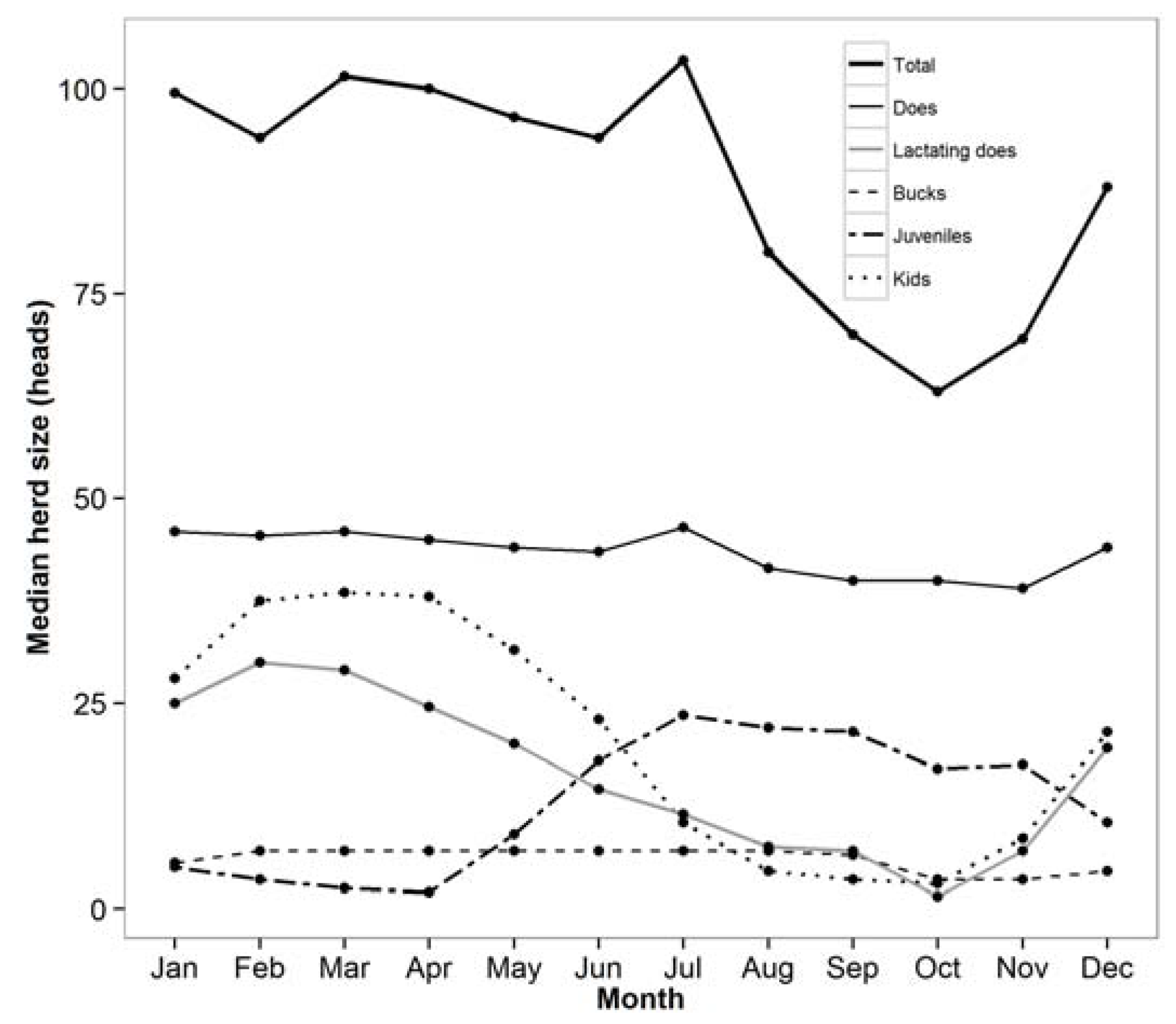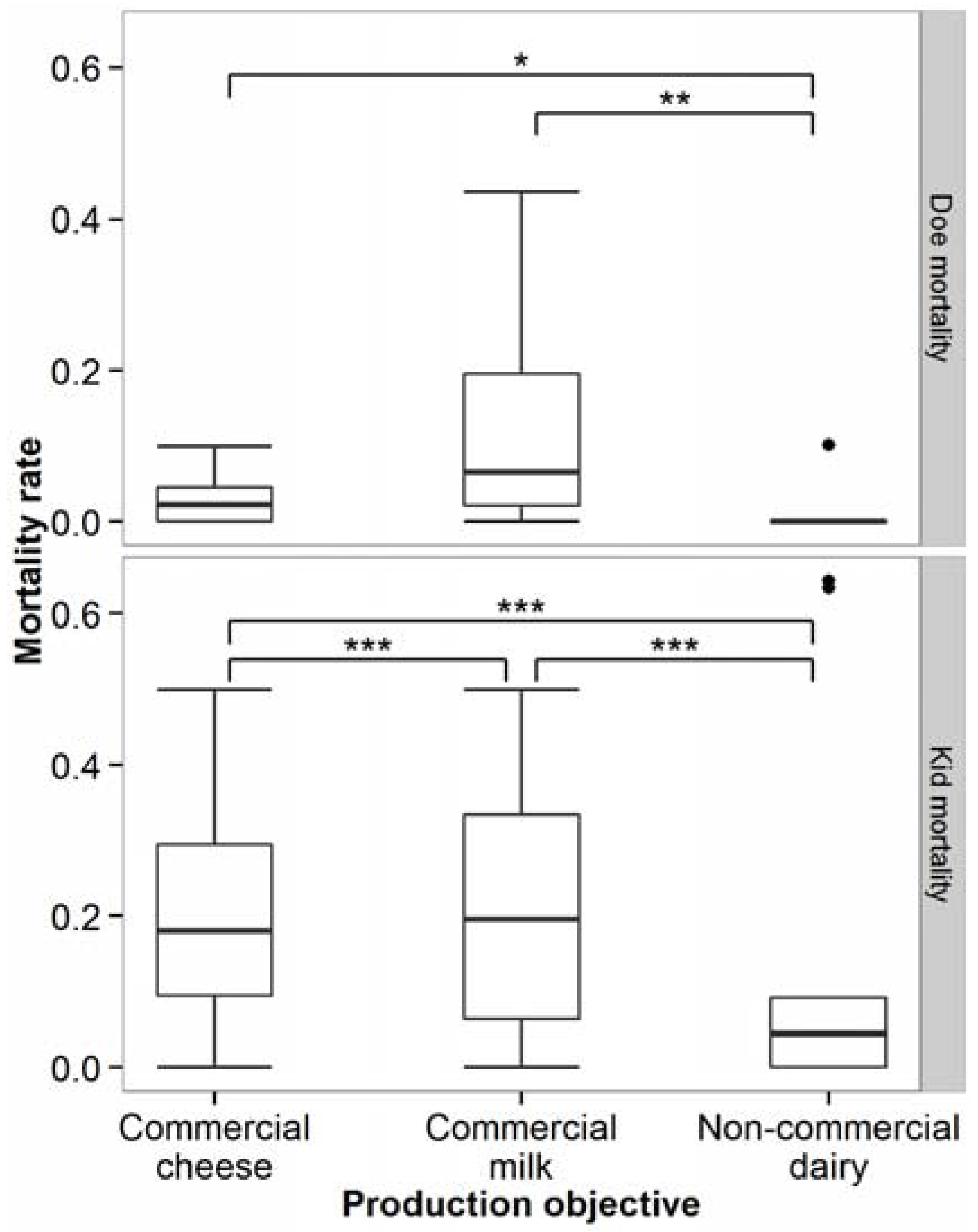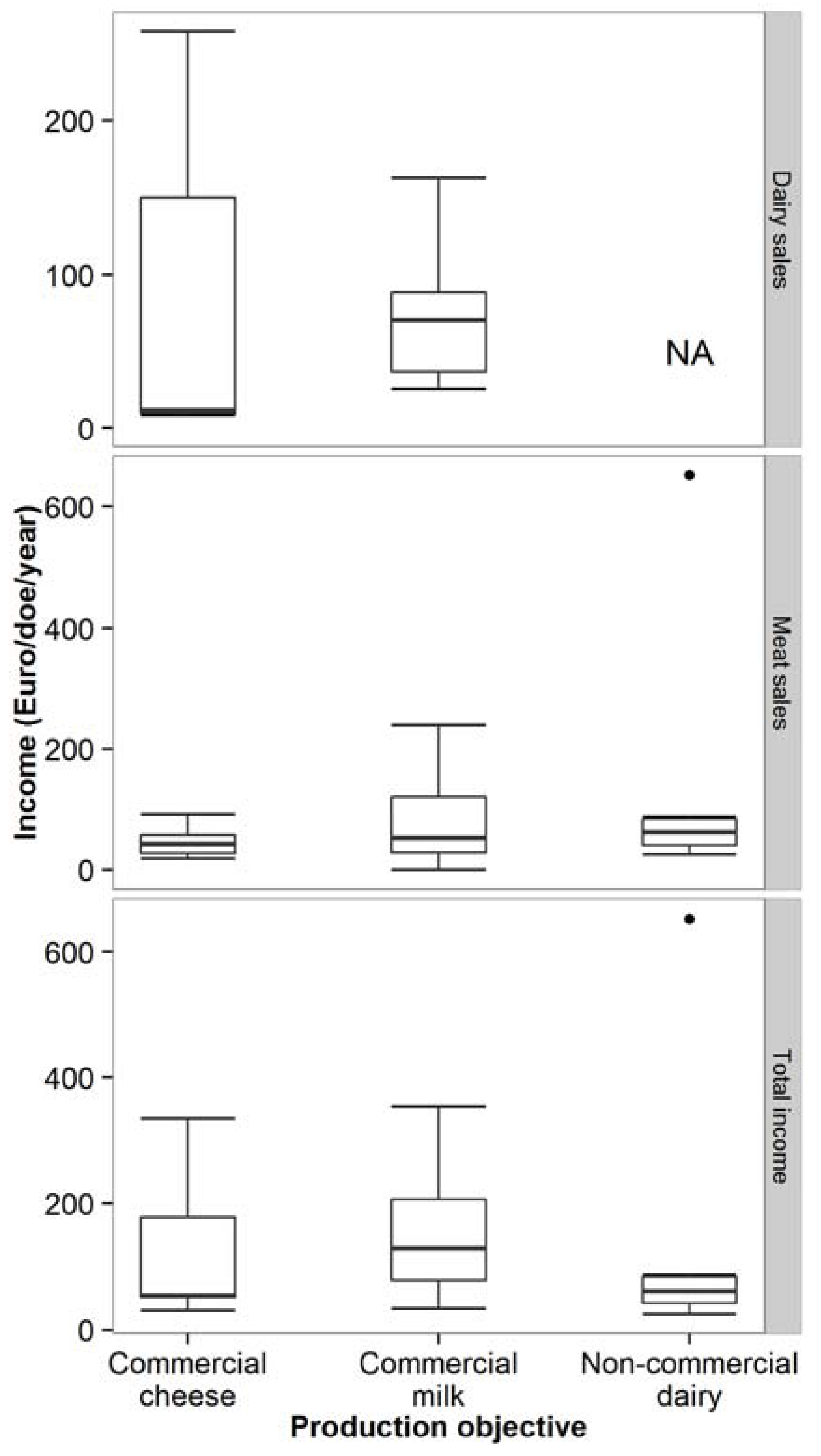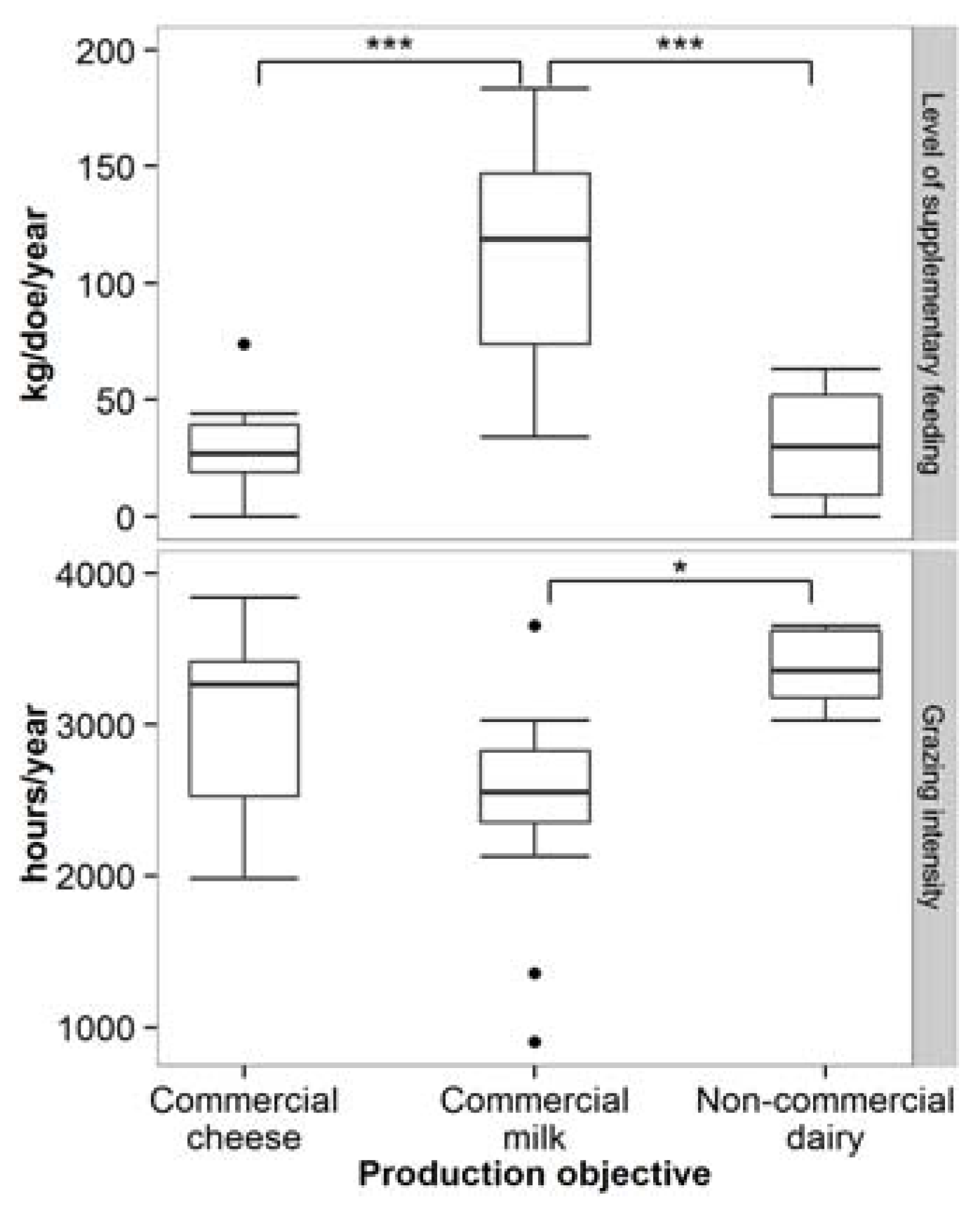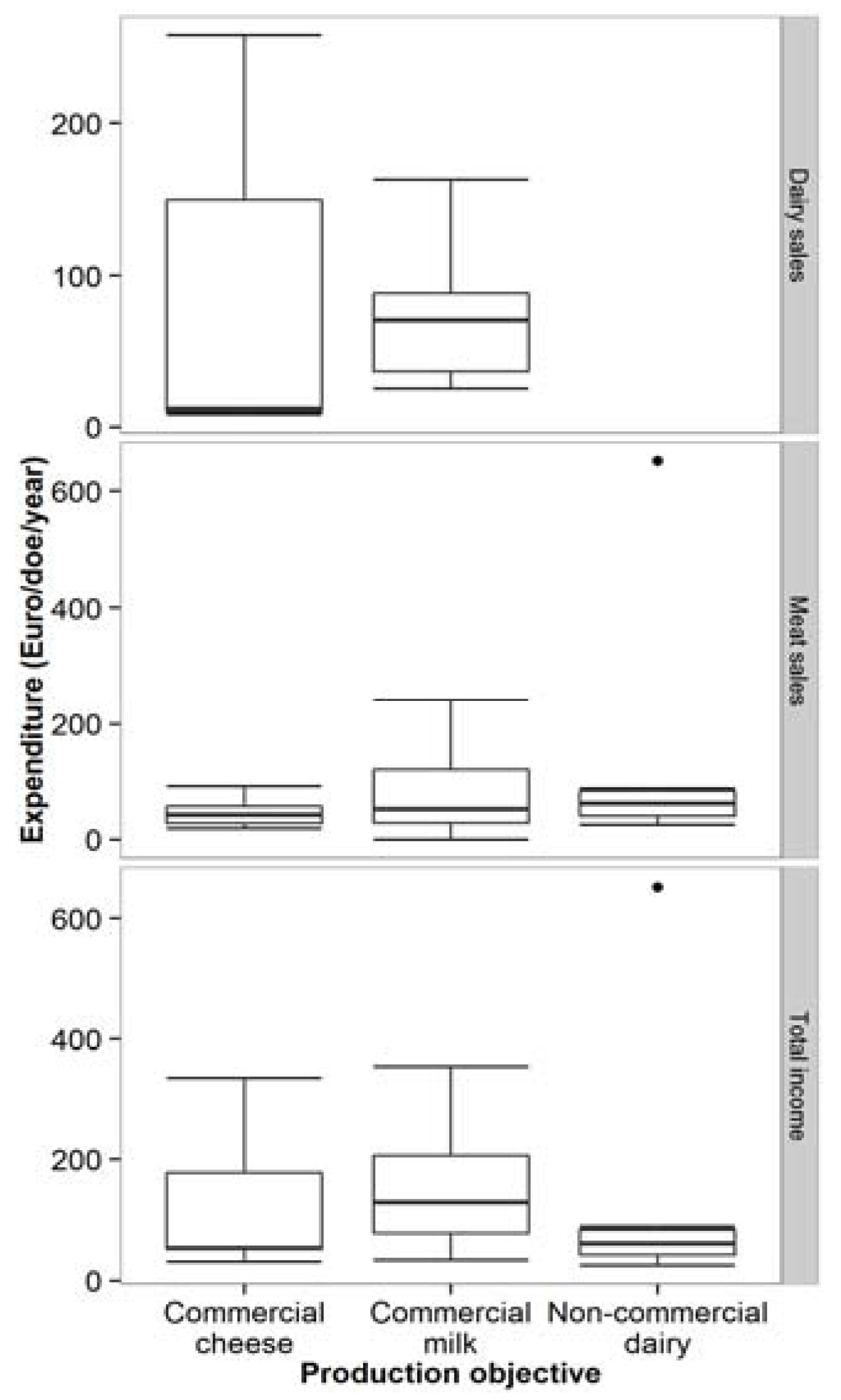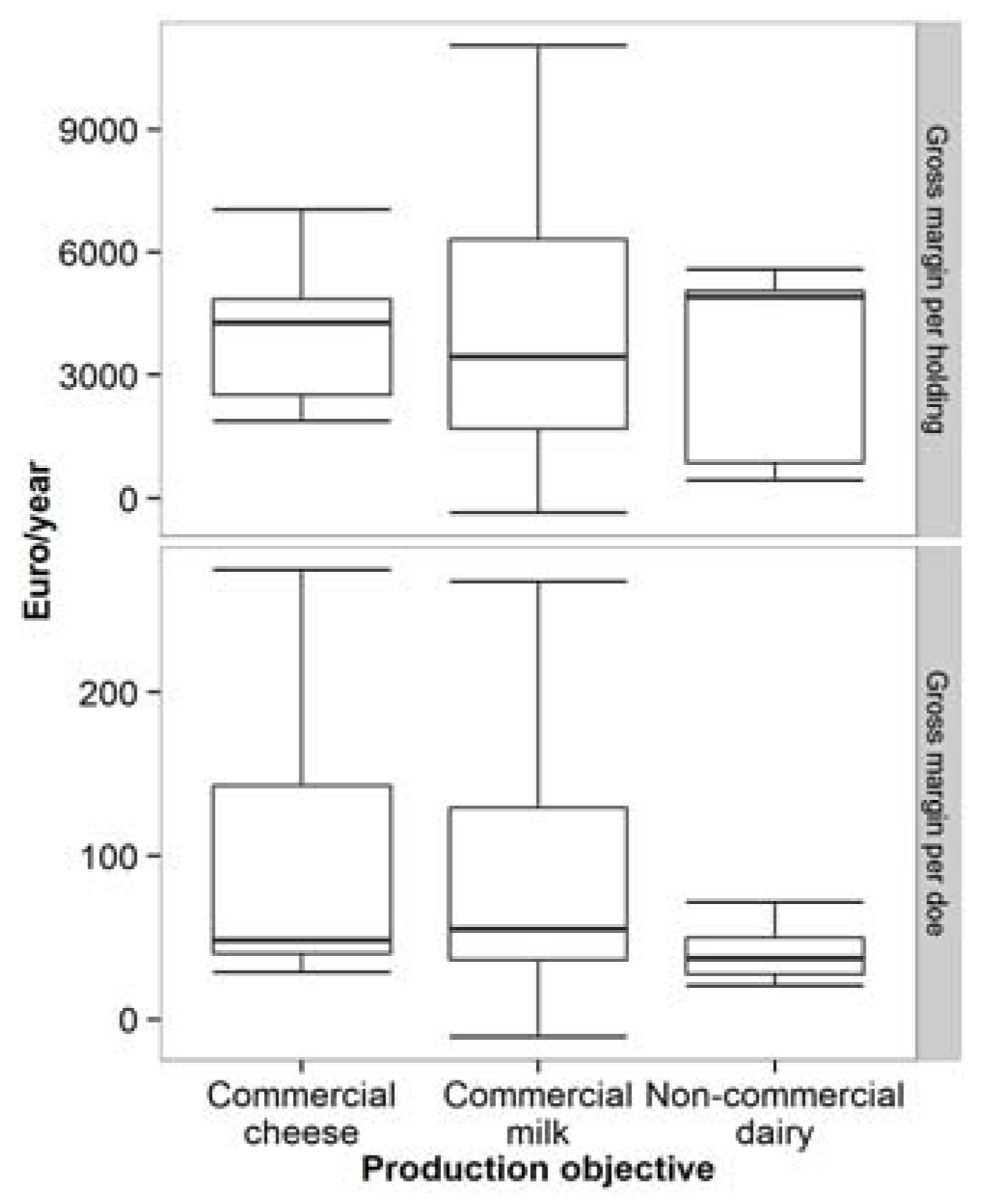3.3. Reproduction
Seven reproductive parameters were calculated, following Pittavino
et al. [
11] (
Table 2 and
Table 4). Seasonality of reproduction has been reported previously in northern Morocco [
9,
22] and in the current study kidding was concentrated between November and February (66% of kidding occurred during this period). This seasonal parturition limits potential milk yield and meat income. Approximately 25% of kiddings produced twins. Although twin births are preferable for meat production, as more animals are available for sale, single births may benefit producers in this region by allowing nutritional requirements to be met more feasibly, particularly as supplementary feed is not readily available or affordable; mortality of twin-born kids increases when forage supply falls [
37].
Abortions were recorded on nine of the ten holdings, with a significantly higher rate of abortion on CM holdings than CC or NC holdings (
Table 4). However, overall abortive rate was less than 0.5%, as previously reported for extensive goat herds in Tuscany [
38] and substantially lower than the value of 2.97% reported in Spain [
19]. Still births were reported rarely.
There were no significant differences in the fertility, prolificacy or fecundity rates between holding types (
Table 4). Similar fertility rates to the current study (85% QCV = 0.39;
Table 4) were observed previously in northern Morocco [
21] and Sardinia [
29], although both higher (92%–93%) and lower (79%–80%) rates have been observed in Morocco [
21,
22,
24] and Andalusia [
25,
33], suggesting that fertility rate is highly variable. Prolificacy rates above 1.35 have been reported in northern Moroccan [
24] and European Mediterranean herds [
20,
26,
29,
33] which are considerably higher than the current study (1.19 QCV = 0.18;
Table 4). Average fecundity in this study, of 0.98 (QCV = 0.45;
Table 4), which takes into account both fertility and prolificacy, shows that almost one kid was produced per doe per year, as reported for meat herds in northern Morocco receiving no supplementation [
22]. As does tended to be supplemented in the current study, albeit minimally, higher fecundity rates might have been expected; higher levels of supplementation may be required if fecundity of dairy goats is to be improved in northern Morocco. A higher fecundity of 1.19 was reported in Sardinia [
29], despite similar fertility rates; these herds had longer grazing periods compared to herds in the current study (14 h
vs. 8 h, respectively) suggesting again that nutrition is having an effect; there is no information, however, on level of supplementary feeding in the Sardinian study. When compared to the fecundity rate of 0.98, the new birth rate of 0.88 (QCV = 0.32;
Table 4) observed here indicates problems associated with kid survival to weaning. New birth rates, ranging between 1.14 and 1.72, were observed in grazing goats in Palmera [
20] and Greece [
27], substantially higher than reported here. New birth rate was, however, significantly higher (more kids survived to weaning per doe in the herd) on NC holdings than CM and CC holdings (
Table 4), suggesting that kid mortality increased with intensity of production in the study region: significantly lower kid mortality rates were found on NC than CC and CM holdings (
Figure 2). Previous Moroccan studies also show lower mortality rates on NC than CC or CM holdings [
22,
24,
39] and in southern Spain lower kid mortality rates were reported for intensive, semi-intensive and semi-extensive herds respectively [
23]; high kid mortality in Morocco has previously been attributed to inadequate feeding due to poor pasture productivity, inefficient use of crop residues and a lack of information on feed concentrate feed quality [
40]. Inadequate artificial rearing practices on more intensive holdings may also contribute to higher kid mortality rates [
41].
Doe mortality rates differed significantly between holding types (
Figure 2). These rates were higher than reported previously in northern Morocco [
24] but lower than in semi-intensive and semi-extensive holdings in southern Spain [
23]. Cull rates were also higher for CM than CC and NC holdings (
Table 4), due to the practice of more selective culling which contributed to the higher doe replacement rate of CM holdings (0.41 QCV = 1.08;
Table 4). Health problems associated with dairy production were not considered in this study, but may have contributed to higher kid mortality, doe mortality and doe culls. These may have been due to nutritional insults. Average reproductive life, equivalent to number of lactations achieved in a lifetime, was six years (QCV = 1.00,
Table 4), similar to that found in Greek herds [
27]. Enhancing reproductive life of the doe can increase profits through increased sales (as fewer offspring are required as replacements), more selective culling (to increase health and productivity) [
42] and herd expansion. Reproductive performance and a high rate of parturition are vital for continued lactation for dairy production, and to produce offspring for meat production [
12]. Therefore optimising reproductive performance is essential for both diversification and intensification.
3.5. Goat Sales
The data do not allow the purpose of the sale of goats to be distinguished (
i.e., for slaughter, fattening or reproduction purposes). There was no significant difference in overall number of males and females sold, though there was a tendency to sell males as juveniles (<12 months of age;
Table 6) and females as adults (>12 months of age;
Table 6). The majority of juvenile females were retained by herds, most likely as replacement stock for culled does. This may also be due to animals being sold by weight, resulting in faster growing females being sold and those growing more slowly retained as replacements; this can increase their age at first kidding due to later sexual maturity, with negative effects on economic returns [
44]. Kid sales were rare (
Table 6), in contrast with previous reports for CC herds in northern Morocco and dairy herds in Andalusia and Greece [
24,
27,
33]. However, more kids were sold on CM than CC or NC holdings (
Table 6), potentially to optimise income. The removal of kids allows a greater yield of milk to be sold and their sale is likely to be considered more favourable than hand rearing with milk replacer, both economically and in terms of labour requirements.
The annual income from goat sales per doe did not differ significantly between holding types, averaging 46.9 €·doe
−1 (QCV = 0.95;
Table 6), highlighting its importance to all producers (
Figure 3). This was equivalent to that reported previously for CC holdings in northern Morocco [
39] and exceeded values reported for Portuguese [
35] and Andalusian [
33] dairy holdings. However, both meat and mixed meat/milk holdings in northern Morocco [
39] and Spanish dairy holdings [
43] have reported higher values. The contribution of sales to income averaged 100% (QCV = 0.00), 61.2% (QCV = 0.88) and 42.8% (QCV = 0.51) on NC, CC and CM holdings respectively (
Table 6), showing dairy production provided an additional rather than alternative income for CC and CM holdings and contributes to both increased food and financial income. This is logical as sales are predominantly of males and cull does; neither are required for the production of milk (on commercial dairy holdings) or new animals for sale (on non-commercial dairy holdings).
3.6. Feeding Practices
Supplementary feeding was practiced across nine of the ten holdings, in contrast with previous reports of meat farms in northern Morocco with no concentrate feeding [
21,
22]. Significantly more concentrates were fed per doe on CM than CC or NC holdings (
Figure 4), indicating that milk production relies on supplementary feeding. Forage supplementation was rarely reported in the current study or previous northern Moroccan studies [
24], possibly due to the high price of forage in this region [
42] which contrasts with reports from European Mediterranean studies [
20,
23,
25,
27,
32,
33,
34,
36]. Supplementation with concentrates has been previously reported for commercial dairy holdings in northern Morocco [
7,
24] and is common practice on European Mediterranean holdings [
20,
23,
25,
27,
29,
31,
34,
36], but at much higher levels than in the current study, which showed a significant positive relationship between the level of concentrate feeding and milk yield per doe. This positive relationship is also reported for French dairy herds achieving very high milk yields [
31] and indicates that this is an important limiting factor for intensification of dairy production.
The low level of feed supplementation in the current study (
Table 7) resulted in annual feed expenditure being at least 45% lower per doe than reported for European Mediterranean herds [
20,
27,
43] although government issued feed subsidies [
45] were distributed to some holdings during the study period, resulting in expenditure being lower than it otherwise might have been. However, Greek indigenous herds [
27] and some Andalusian herds [
33,
34] have reported similar feed expenditures per doe to CM holdings in the current study. The Greek and Andalusian herds, however, fed more concentrates per doe than in the current study, in addition to not receiving any feed subsidies, suggesting lower feed prices in those regions. This again indicates the constraint on diversification in northern Morocco due to feed access. Feed is often the main cost of livestock production [
46], and in the current study, accounted for 72% (QCV = 0.18), 69% (QCV = 0.38) and 35% (QCV = 0.82) of total expenditure on CM, NC and CC holdings respectively (
Table 7), despite the subsidies. For CM holdings this value was similar to reports from French dairy herds (79%) [
31], although expenditure per doe was substantially lower in the current study (
Figure 5).
3.7. Gross Margin
Gross margin is the difference between total annual income and expenditure. Total annual income is the sum of the annual income per holding from dairy sales, goat sales and diverse sources (
Table 8). An income from diverse sources, typically the sale of manure, was recorded by six holdings (four CM, one CC and one NC holding) and had a low contribution to total income (
Table 8). Although considerably higher incomes were seen on some CC and CM holdings than NC holdings, there was no significant difference in total income between holding type (
Figure 3), which averaged 77.8 €·doe
−1 (QCV = 1.41;
Table 8), similar to previous reports for northern Moroccan meat herds [
39] but substantially lower than European Mediterranean [
25,
27,
33,
35,
47] and northern Moroccan [
39] commercial dairy herds.
Total annual expenditure is the sum of the recorded annual expenditure on variable costs (feed purchases and production, veterinary and medicine, replacement goat purchases, cheese production and additional costs) per holding (
Table 8). Additional costs are the sum of expenditure on supplements, milk replacer, cleaning products, lime, fuel, casual labour, repairs and feed transport costs; it was not possible to segregate these costs, which did not differ significantly between holding type (
Table 8). Fixed expenditures, such as the cost of rent and labour, were not included, except for instances where casual labour had been included in feed and diverse production costs and cannot be identified for removal. However, these costs are likely to be low as virtually all labour is unpaid family labour and rented land is uncommon (
Table 3). Consequently, net returns are unlikely to differ greatly to gross margin. Despite median annual expenditure being more than double on CM than CC or NC holdings (
Figure 5), after controlling for herd size there was no significant difference in total annual expenditure between holding type, which averaged 36.2 €·doe
−1 (QCV = 2.09;
Table 8).
Gross margin was negative (expenditure exceeded income) on two holdings during one year of the study. Overall, annual gross margin ranged from −1220 to 7600 Euro (median = 2650 € QCV = 1.10;
Table 8), equivalent to between −14.3 and 239 €·doe
−1 but did not differ holding types (
Figure 6). The average gross margin of 36.1 €·doe
−1 (QCV = 1.10;
Table 8) was more than double that reported previously for meat herds in northern Morocco [
22,
39] but less than half that reported for cheese and milk producers in Morocco [
39] and substantially less than 61.4 €·doe
−1 reported for indigenous Greek herds [
27] achieving similar production results. Somewhat higher gross margins per doe have been reported in Portugal [
28] and Andalusia [
34], whilst considerably higher gross margins (up to 253 €·doe
−1) have been reported for numerous other European Mediterranean studies [
27,
31,
33,
34,
35,
47]. Gross margin of the herd shows the same differences; this means that the technical underperformance of northern Moroccan goat herds results in a financial underperformance. Therefore the financial cost of any intervention to improve technical performance needs to be outweighed by the improvement in financial income; increasing yields improves food security, but can have negative effects on the farmer [
48]. The system may be optimised by improving the goat value chain for increased returns [
49].
3.8. Future Outlook
The current study, and the results from other Mediterranean grazing goat systems, indicate that the level of supplementary feeding is strongly related to successful dairy goat production; higher levels of supplementary feeding allowing higher productivity. Currently, very few holdings in the region are specialised in dairy production to achieve annual milk yields above 200 litres per doe. These milk yields are only possible when higher levels of supplementary feeding are provided. As there is limited accessible supplementary feed in northern Morocco, it is essential that goat producers are supported to explore alternative feeding and overall production strategies to achieve intensification, rather than focussing solely on an increase in dairy production, particularly as goat meat demand and consumption is also increasing in Morocco.
A lack of accessible feed has traditionally been overcome by herding livestock long distances [
45], but is not a feasible option if the aim is to intensify dairy production; this practice can lead to the over-grazing of land [
50,
51], particularly as the region relies on collective ranges and state forests for grazing which can be difficult to manage sustainably [
40] and lack energy and protein during dry periods [
52]. It is important to combat desertification and conserve biodiversity in the region [
40,
53,
54] to avoid a high abundance of unpalatable browse, protect long-term food security [
55] and safeguard animal health and welfare [
41]. Some regions in the Mediterranean have banned rangeland grazing by goats in order to prevent further degradation, but have failed to provide guidance on alternative feed resources [
56]. However, under controlled management, grazing is often beneficial to maintenance of open agroecosystems [
50,
54,
57,
58,
59,
60,
61,
62]. Both grazing quality and production of supplementary feed are likely to be further compromised in the future as a reduced intensity of precipitation, an earlier onset of drought and an increase in dry days has been predicted in the region [
45,
63] and has already degraded some rangeland [
40]; a shift to sedentary grazing with intensification opposed to the traditional transhumant grazing is further decreasing rangeland productivity and goat performance [
50,
64]. Therefore supplementary feeding is likely to become an even greater necessity in all goat production systems, regardless of their level of intensity.
One solution is to provide financial support [
37] whilst improving import policies and infrastructure for obtaining and distributing feedstuffs. Steps towards this were taken in the 1960s, when the Moroccan government authorities established feed subsidies during periods of drought [
45] which are still in operation today [
50]; some of these were received by holdings in this study. However, the current study shows that despite this, feed supplementation remains a factor that limits dairy goat production in northern Morocco, possibly because safeguarding of human nutrition, rather than livestock nutrition, is the primary objective during droughts [
45] whilst forage production is low [
40], highly variable between seasons and years [
65] and difficult to control [
50]. Furthermore, feed subsidies often result in more sedentary grazing practice, increasing rangeland degradation [
50,
66]. This indicates a need to explore alternative feeding strategies.
Many studies have shown home-produced forage, or limiting purchased feed, to be the most profitable feeding solution [
23,
65,
67,
68,
69,
70,
71], with additional environmental benefits. However, forage production is rarely practiced in this region [
66]. Therefore a potentially more sustainable approach would be to explore alternative feeding strategies [
52], particularly forage options [
72], which utilise local resources, are simple and are cost-effective. This will require the guidance of technical advisors [
66], as the current socio-economic status of the region limits pasture and forage resource improvement due to insufficient technical support and the vulnerability to drought [
40]. The use of alternative feed resources in goat production has been reviewed in detail [
37,
52,
66,
73,
74,
75,
76] and potential strategies include: by-products from olive production [
77,
78] which has been promoted under the “plan Maroc vert” agricultural strategy [
79]; salt-tolerant shrubs such as saltbush; cactus; ensiling technologies; and feed-blocks of local agro-industrial by-products. Although addition of polyethylene glycol, activated charcoal or calcium hydroxide to the diet can improve rangeland utilisation and goat performance, it can also increase rangeland degradation [
76] so should be used with care.
Adaptive grazing schemes, which combine these alternative feed resources with strategic or conservative rangeland grazing, could balance the insufficient quality and quantity of rangeland resources during periods of high nutritional requirements [
50,
65], reduce the grazing period [
80], reduce grazing pressure on the land [
55], reduce the energy expenditure associated with grazing [
81,
82], reduce the labour requirements associated with herding, and avoid the high costs of imported supplementary feeds which reduce net household income [
83]. In addition, a moderate use of alternative feed resources could support dairy production and overall biological performance of the local goat breeds. This could lead to the establishment of a supply-driven, rather than demand-driven, feeding management as part of a whole system approach for the region to further improve the sustainability of intensification [
84].
A supply-driven approach balances animal requirements with feed production [
85] by matching the system to locally available feed resources, in addition to implementing reproductive management and breeding programmes which complement the characteristics of the region alongside health control programmes [
54]; the recent link between the re-emergence of brucellosis, a zoonotic disease, and intensification of livestock production in Morocco [
86] in addition to the association of production diseases with intensification [
87], highlights the latter element. In this approach, pasture utilisation and alternative feed sources are related to the kidding season [
32] and could be more effective than sophisticated genetic improvement programmes [
88]. It is also necessary to consider how productivity, management practices and marketing strategies are affected by the environmental, economic and socio-political factors of the region [
72]. This concept, applied through a participatory approach, has been successful in many low-input goat systems [
5,
44,
84,
89,
90] in addition to Moroccan dairy cow systems [
91]; farmers’ knowledge of the region is supported by that of researchers and extension personnel. This participatory approach, alongside the development of co-operatives [
91,
92], could improve uptake by farmers and reduce communication gaps between stakeholders [
54]. Although factors outside the farmers’ control influence farm profit and efficiency, it has been shown that approximately three quarters of the variation in farms reaching their profit potential is a result of farmer management practices [
93] and their involvement is therefore paramount.
Whole-farm models may provide further understanding of the complex interaction of biophysical and socioeconomic factors relating to intensification and the value chain [
65,
94,
95,
96,
97]. For instance, modelling has shown that in dairy cow systems with restricted feed resources, maintaining low milk yields per animal but increasing herd size to improve overall milk yield is a more favourable strategy than attempting to increase the milk yield per animal [
98]. However, a shortage of labour limits herd expansion in this region [
22] and larger herd sizes could increase rangeland degradation [
83]. In addition to implementing alternative feeding strategies, a mixed meat and dairy semi-intensive production objective based on enhanced local genetics, rather than a specialised dairy system, may increase the technical performance of goat production for greater financial returns and overall financial viability of intensification, whilst helping to meet the increasing demand for and consumption of goat meat in Morocco. This would allow the sale of non-breeding stock at the onset of a drought season to reduce pressure on feed sources later in the season [
37]; this may also be a successful rangeland management strategy but only if livestock productivity and mortality rates are not the primary objective [
99]. However, this indicates a need to explore very diverse alternative management strategies; the intensive dairy goat model developed in France, and to a lower extent in Spain and Portugal, is unlikely to be successful in Morocco due to the climatic and socio-economic constraints.
The remote location of the goat holdings in this study not only limits their access to resources, but also the distribution of their products; this has been observed in similar systems around the Mediterranean [
56]. Therefore, infrastructure improvements will also be key to strengthening the market for goat products in the region [
93]; development strategies and policy should focus on education and access to information, distance to markets, herd sizes and availability of alternative feed resources [
56,
93,
98,
100]. To aid successful commercialisation and market expansion, additional activities are likely to be necessary within the value chain. For instance, producers may be required to meet more stringent food safety rules and animal health targets [
101], whilst the use of commercial abattoirs could become compulsory for meat production, necessitating the transportation of goats, and dairy production may require pasteurisation procedures and improved cold storage to achieve commercially acceptable shelf-lives. These activities will require both training and financial input [
101], and potentially a high level of governance and policy interventions for success [
102] through extended and efficient extension services. This aspect is often under-analysed in current value chain research [
96], which should attempt to include the effect of climatic shocks and trade barriers, the environmental impact of intensification and the local and regional competition for resources and market for products [
96].
